13 Plants That Look Like Marijuana, but Are Not Cannabis
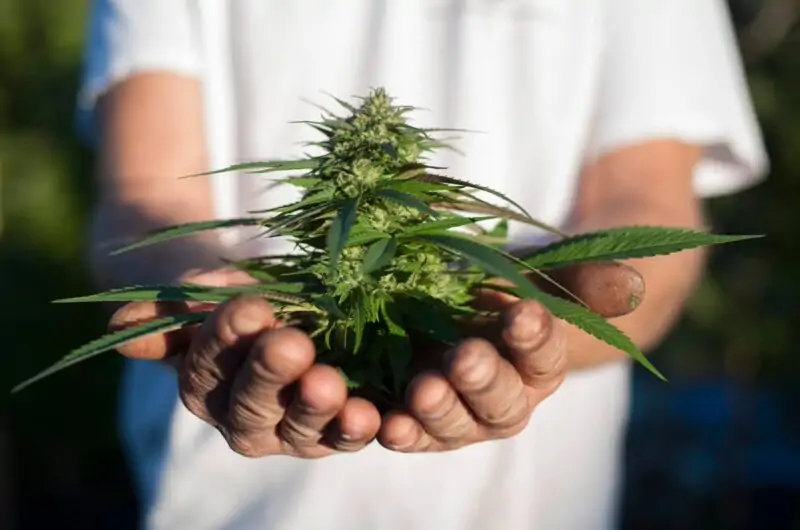
Have you ever taken a second look at a plant because it resembles cannabis? In this article, we’ll explore 13 plants that look like marijuana and how to tell them apart from the real thing.
Some plants indeed look similar to cannabis, and you can easily mistake them for marijuana, especially if you’re not a botanist and not familiar with their characteristics. However, not all plants that look like weed are really weed, and knowing the difference might sometimes be crucial since growing or possessing marijuana may be illegal in your state or country. We’ll also answer common questions about legal issues related to growing similar-looking plants.
Importance of Distinguishing Marijuana from Its Lookalikes
Mistaking other types of vegetation for marijuana can have legal consequences. For instance, law enforcement officials might suspect that someone who owns certain herbs or flowers is cultivating weed illegally simply by visual inspection alone.
It’s essential to know what each plant looks like to avoid misunderstandings and inadvertently getting yourself into trouble.
Brief Overview of 13 Plants That Look Like Marijuana
The list below contains 13 different kinds of flora resembling Cannabis Sativa L:
- Japanese Maple
- Southern Marigold
- Sunn Hemp
- Coral Plant
- Okra
- Cassava
- Spider Flower
- Texas Star Hibiscus
- Kenaf
- Chaste Tree
- Japanese Hop
- Sweet Fern
- Mint
Let’s dive deep into understanding each one individually:
1. Japanese Maple (Acer palmatum)
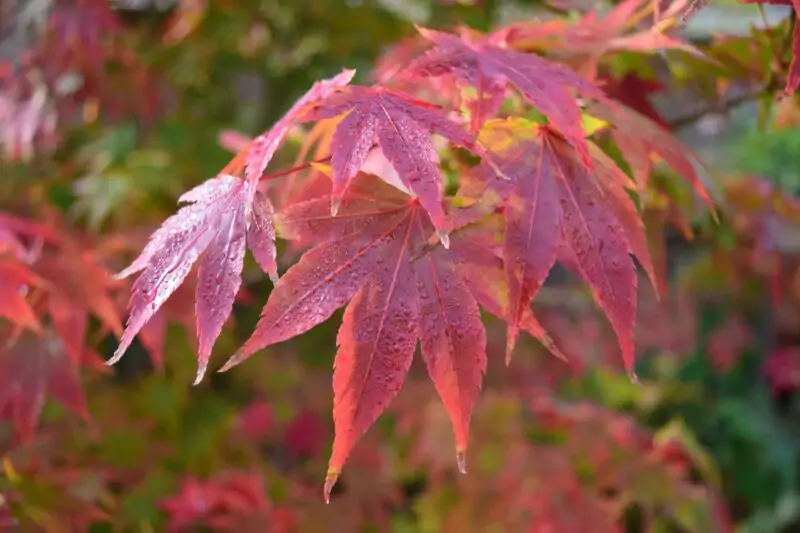
- Japanese maple has leaves similar to those found on cannabis plants, but they are often smaller in size.
- Leaf shape: The leaves are palmately lobed, meaning they have five points radiating outwards.
- Differences in color and growth pattern: These maples vary in color but usually remain green until autumn, when oranges, reds, and yellows emerge through their veins, resembling fall colors before dropping off completely during winter months.
2. Southern Marigold (Tagetes minuta)
- Southern marigolds have leaves that are very similar to cannabis plants, but they differ in their flowers and scent.
- Similarities in leaf structure: Leaves of the two species look alike with jagged edges or serrated margins.
- Differences in flower and scent: The fragrance produced by southern marigold is pungent, which differs from marijuana’s sweet aroma.
3. Sunn Hemp (Crotalaria juncea)
- This plant has a striking resemblance to hemp; it belongs to the legume family.
- Resemblance in leaf arrangement: Three obovate-shaped leaves grow closely together at branch tips.
- Differences in flowers and height: Yellow-colored pea-like flowers bloom on long spikes extending beyond their foliage during summertime.
4. Coral Plant (Jatropha multifida)
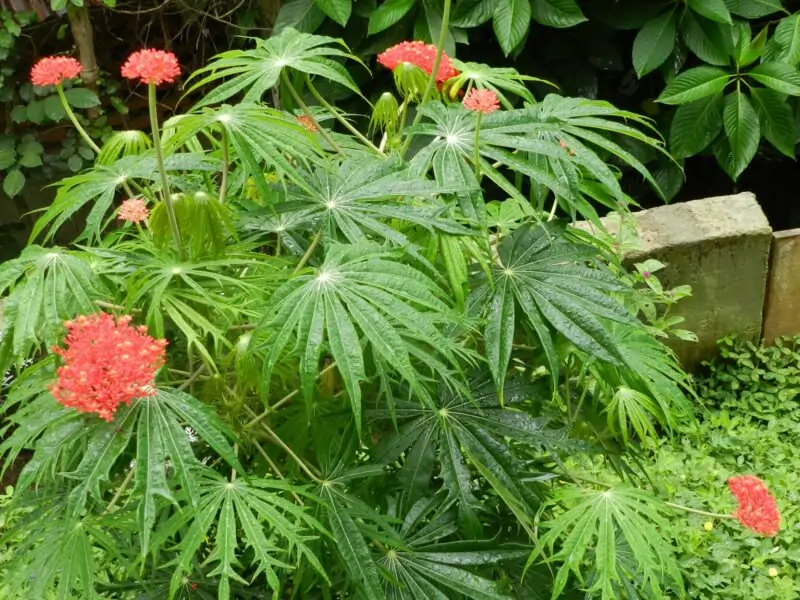
- Like Cannabis Sativa L., Coral Plant has lobed leaves as well, though somewhat larger than those found on weed plants.
- Similarity in leaf lobes: They both have seven lobes splitting into narrow pointed sections like fingers.
- Differences in leaf arrangement and flowers: This tropical flowering shrub displays red coral-like blooms throughout the year, unlike marijuana.
5. Okra (Abelmoschus esculentus)
- Also called “Lady Fingers,” Okra’s fan-shaped leaves are extremely similar to marijuana’s. However, okra fruits can be clearly distinguished from cannabis buds by looking at the differences between them.
- Similar leaf shape: The okra’s leaves that look like a fan make it easy to confuse with marijuana.
- Difference in plant size and fruit: Unlike cannabis, Okra grows taller when reaching maturity and develops large green seed pods.
6. Cassava (Manihot esculenta)
- While not as similar to cannabis as other plants on this list, cassava still bears some resemblance to marijuana leaves.
- Leaf shape resemblance: The shape of cassava leaves and their serrations make it somewhat similar to cannabis leaves.
- Differences in plant size and root structure: Cassavas grow considerably larger than weed plants and produce pendulous, white root balls.
7. Spider Flower (Cleome hassleriana / spinosa)
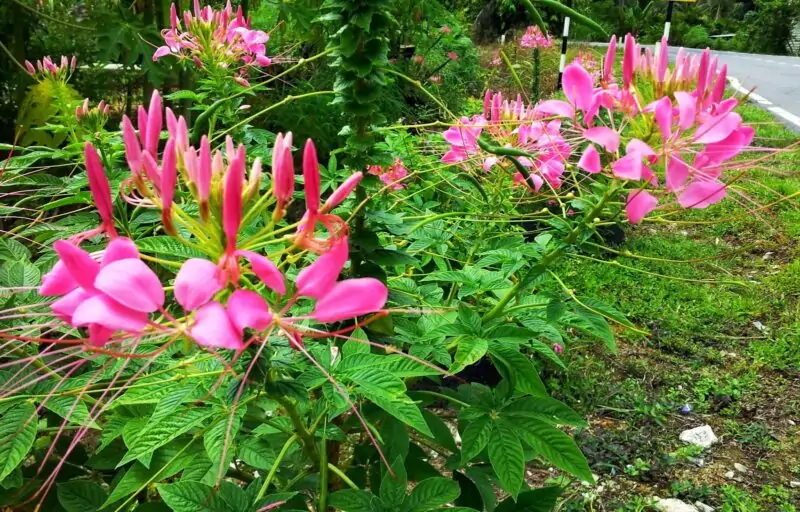
- The spider flower shares some similarities with hemp plants, particularly in its agronomical properties. This plant usually grows taller than most weeds, is robust, and can survive even under adverse conditions such as droughts.
- Similarity in leaf structure: Each of the compound leaves consists of three or five palmate-shaped lobes with smooth edges.
- Differences in flowers and growth habit: The spider flowers’ elongated clusters consist of small pinkish-white blooms appearing on tall stems, unlike marijuana.
8. Texas Star Hibiscus (Hibiscus coccineus)
- Texas star hibiscuses have large, wide-open flowers similar to cannabis plants, but they’re distinct enough to tell them apart. Their foliage color varies from deep green to olive-green shades, while the buds develop into bright red petals resembling Hawaiian lei necklaces.
- Similarity in leaf shape: Both display heart-shaped structures.
- Difference in flowers and texture: Texas Stars have a velvety texture when touched and bloom during midsummer.
9. Kenaf (Hibiscus cannabinus)
- Although not very closely related, Kenafs are still among many crops associated with the Cannabis family due to their visual similarities. They’re popular for being sustainable alternatives to wood-fiber production since they produce far more per acre compared to other sources like trees.
- Resemblance in leaf shape: Like cannabis, kenaf displays simple, alternately arranged lanceolate lobe-like samarae.
- Differences in plant height and flowers: Kenaf plants are shorter than cannabis, and their flowers are usually brown or yellow, growing on upper leaf axils.
10. Chaste Tree (Vitex agnus-castus / negundo)
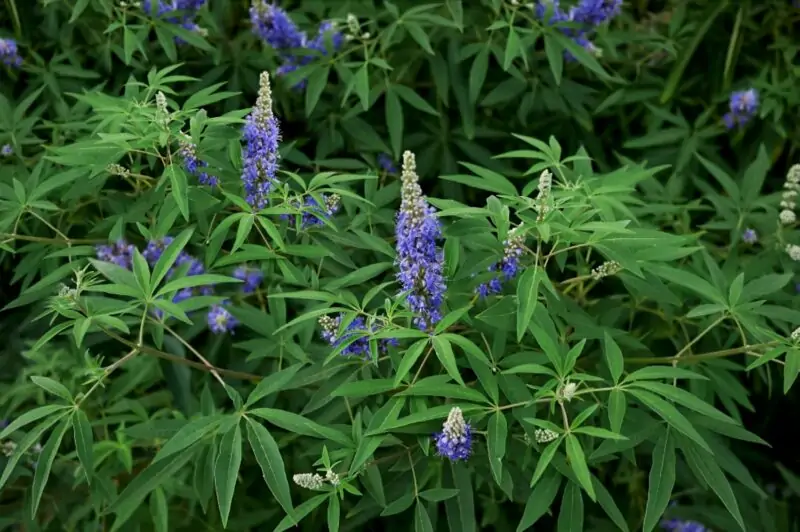
- Chaste trees, another common name for the herb Vitex, have a close resemblance to cannabis with their deep green leaves.
- Similarity in leaf arrangement: Leaves look very similar and grow opposite each other from woody branches.
- Differences in flowers and leaf color: The chaste tree is shorter than marijuana; it produces small pale violet blooms and has a silvery-green color on its leaves.
11. Japanese Hop (Humulus japonicus)
- Japanese hops have delicate pointed foliage that mimics Cannabis Sativa L.
- Similar leaf shape: Just like cannabis, hops display serrated edges with five-pointed lobes.
- Difference in plant growth and flower structure: Japanese hop grows slender vines while producing tiny fruits (burrs).
12. Sweet Fern (Comptonia peregrina)
- Sweet ferns’ resemblance to marijuana comes mainly from both species having similar distinctive leaves.
- Resemblance in leaf shape: The sweet fern’s fronds possess narrow oblong-like shapes, just like marijuana plants.
- Differences in size and growth habit: Unlike most marijuana plants, sweet fern shrubs remain low-growing, typically under three feet.
13. Mint (Mentha spp.)
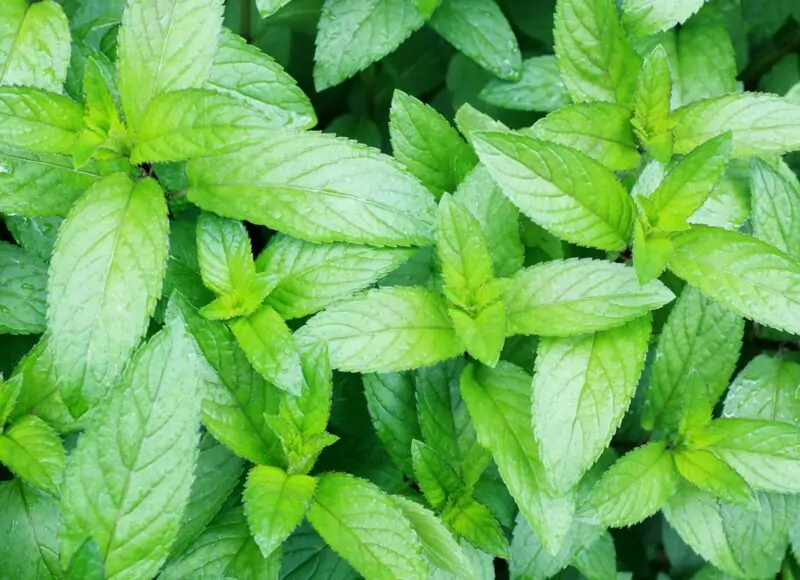
- Mint leaves have an arrangement pattern called ‘opposite,’ which makes their appearance easily confused with cannabis leaflets. The mint plant also offers several valuable health benefits, such as improved digestion and reduced inflammation.
- Similarity in leaf arrangement: Mint displays pairs of oval-shaped, toothed-edge leaves growing directly across from one another.
- Differences in scent and plant size: Mints offer a cool menthol scent, unlike the cannabis fragrance. They also grow relatively short compared to cannabis plants.
How to Identify Cannabis Leaves
Knowing how to differentiate marijuana leaves from other plants’ foliage is crucial. Here are some characteristics you can use:
- Shape and arrangement of leaflets: Marijuana leaves have an odd number of leaflets, usually ranging from 5 to 9 or more, arranged in a palate pattern on the stem.
- Characteristics of leaf texture and color: Cannabis plants’ leaves are generally broad with jagged edges or serrated margins. They also have shades ranging from dark green (when healthy) to pale light green, depending on the variety.
- Differences in the plant’s overall structure: Marijuana often appears bushy compared to most look-alike species.
FAQs
The cultivation and possession laws for each type may vary by country and state; however, it’s always better to be safe than sorry, so make sure to check your local regulations.
Although these plants share similar physical features like those described earlier, you should consult an expert botanist if you’re unsure about identification since there could be significant differences between them, which only professionals might be able to spot right away.
Most herbaceous vegetation resembling cannabis poses no threat when consumed appropriately, but every now and then, one can come across poisonous varieties. Therefore, refrain from picking up random herbs without proper knowledge.
Conclusion
It can be essential to learn how to differentiate various types based on their distinctive features, even though similarities exist between different strains. It is advised that we don’t take chances nor risk getting into trouble due to a lack of knowledge about individual shrubs or trees.
Hopefully, this guide helps clear up any misconceptions regarding the plants that look like marijuana: knowledge is power as they say!